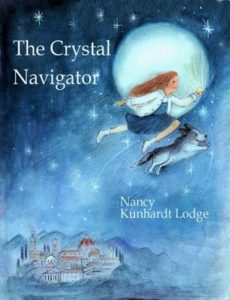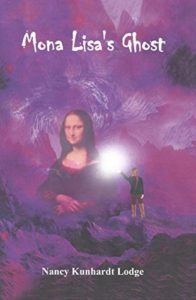Writing Science Fiction Fantasy for Middle Graders
I am thrilled to have this opportunity to talk about my books on Unleashing Readers. I came to fiction writing late, having spent most of my career as a professor at universities in the U.S. and in Italy. I have a PhD in Renaissance Art History, and it never occurred to me that I would someday write books for children. However, it must have been inevitable because my grandmother, Dorothy Kunhardt wrote some of the best-loved Picture Books of all time, the most famous of which is Pat the Bunny.
Learning to write fiction
Five years ago, I decided that I wanted to write books that would bring art and artists to life for children between the ages of nine and twelve. When I stopped teaching to write The Crystal Navigator, I knew nothing about writing fiction. However, I have been an avid reader all my life and to write well, one must be well read. Reading books by great writers like Ann Tyler, Flaubert, F. Scott Fitzgerald, Evelyn Waugh, and of course, E.B. White is the most instructive way to learn how to construct a beautiful sentence without being flowery and sentimental, how to avoid using clichés, how to show rather than tell.
The rules laid down by the how-to write books- never use adverbs, stay away from adjectives too, don’t begin a book with a dream, waking up, walking on a beach- paralyzed me. Once I decided to forget them and wrote without worrying about rules, my writing became much better. However, it takes practice to be a good writer, and it takes time to learn how to edit. I had to teach myself not to get sidetracked with things that had nothing to do with the story. Every sentence must move the action along or the reader will get bored.
I think there are two ingredients that that make a good writer. First, great writers have read enough great literature to have internalized the rhythms of the written word. If you know what a sentence should sound like, you’ll be able to write sentences. Second, all great writers are great storytellers, and it’s the storytelling who keep us up at night. “Stylish writers make you admire them, but storytellers force you to read the next chapter.” I can’t remember where I read this, but it’s helpful. It takes a huge burden off my mind. Just allow yourself to write the story and worry about the writing later.
My Aim
My aim is to inspire a love of reading and spark of lifelong love of art. There are so many wonderful stories about the lives of great artists -what they were like, and the circumstances surrounding their most famous paintings-I knew would delight children.
A Literary Upbringing Helps
I grew surrounded by books. I gobbled up the Oz books, Alice in Wonderland, and I was addicted to Nancy Drew. Although I don’t think it makes a writer, I think it helps to grow up in a literary family. My maternal grandmother was a Lincoln scholar and author of fifty children’s Picture books. My father was a professor at Harvard Business School, who wrote books about ethics and economics. His father, Henry Cabot Lodge wrote about his experience in Viet Nam. And my great grandfather, George Cabot Lodge was a poet.
Plot and Characters Development for Mona Lisa’s Ghost?
Usually, I have a hard time coming up with a plot, but it was easier in the case of Mona Lisa’s Ghost. There are three sources of inspiration for the book. In 2004 I read an article about the Louvre Museum’s plans to scan the Mona Lisa to measure the paint layers. I thought ‘how ludicrous and yet how typical of art historians.’ On the other hand, what a great starting point for a mystery. A monstrous and deadly Spectrographic Scanner zooms into the Mona Lisa and causes a ghastly molecule-destroying syndrome. The second source of inspiration was the otherworldly landscape in the background of the Mona Lisa. It is truly a fantasy, where snow-capped mountains exist alongside sunlit rippling lakes and streams. I thought how wonderful it would be to enter the painting at the horizon-line, so I wrote about portal into the background of the painting. Finally, I was inspired by Einstein’s idea of creating our own reality was the third inspiration.
My character, Lucy is probably pretty much a self-portrait. She is braver than I am, but her impatience and humor are mine. My character Sam, the eleven-year-old genius is inspired by a dear cousin. Sam is an inventor with a wide knowledge of physics, communications, and Einstein. I had to read articles about physics, underground rivers, sound waves, how the telephone works, hence ‘faulty feedback loops.’ I like to think up interesting, fun things for Sam to invent, such as his program called Roving Tentacles, a digital, steerable telescope thingy and can go around corners and investigate or the Plasma Pinch, cloaking a person with plasma-like sound waves.
The Books
Drawing on my knowledge of art history, I have written the first two books in the Lucy Nightingale Adventure series about an eleven-year-old girl, as she learns to value herself and others. In both The Crystal Navigator and Mona Lisa’s Ghost, I incorporate art historical fact into a fantasy world where children travel alongside my protagonists, Lucy and her magical guide Wilbur. I want them to feel the exhilaration of flying though a star-crowded night and feel the spongy grass under their feet, as Lucy and Wilbur jump onto Sandro Botticelli’s flower-strewn meadow in his painting, the Primavera. I wanted children to imagine what it would be like to be hurled into the night sky over the little village in Vincent van Gogh’s Starry Night or to find a portal into the background landscape of the Mona Lisa.
In The Crystal Navigator, Lucy goes back in time to meet and helps famous artists. For example, she helps Leonardo da Vinci achieve the right expression on Lisa’s face. Lisa is a fun-loving, somewhat naughty teenager. Leonardo is at his wits end trying to stop her from making funny faces. He is about to give up when Lucy whispers to him, “Why not ask her husband to surprise her? Maybe she will smile the right way.” Sure enough, when Lisa sees her husband, her eyes light up with love and she smiles in the mysterious way that allows Leonardo to capture her soul.
On the rainy evening Lucy and Wilbur visit Michelangelo in his leaky hut in Rome, they find him in a particularly grumpy mood. He is furious because it’s always too dark for him to sculpt when he gets home from painting the Sistine Chapel. Lucy thinks of an ingenious way to help him see his sculptures at night. “Glue a candle to the visor of a wide-brimmed hat and you will have plenty of light to see your sculptures.”
Her last visit is with Vincent van Gogh in the year 1889 at the asylum in St. Remy, France. Vincent shows Lucy his panting, Starry Night and asks her what she sees. Lucy tells him she sees a “stormy painting, everything moves like ocean waves. The cypress tree is like a sea monster.” She marvels at the thick paint, the choppy lines of his brushstroke, and the smear where he dragged his finger through the paint. He tells her about his fears and she tried to comfort him.
Kirkus Reviews wrote this about The Crystal Navigator, “… Throughout this entertaining, fantastical debut, the author brings the artists and their paintings to life with resonant, informed vignettes. Each funny or soulful encounter gives Lucy opportunities to realize that she’s also an original, smart thinker…A vividly written work of juvenile fiction that mixes fantasy and suspense with messages of empowerment, history, art, and science.” The book won a Mom’s Choice Award and Readers’ Favorite Best Educational Book of 2015.
This year, while editing Mona Lisa’s Ghost, book two in the series, I was lucky to have a group of bright sixth graders from a local school to help me with dialogue and plot. The book revolves around Leonardo da Vinci’s mysterious portrait of Lisa Gherardini and combines themes of reincarnation, science, and the theft of the Mona Lisa. Lucy and her best friend, Sam have formed SLARP, (Sam and Lucy’s Anomalies Research Project,) to investigate odd happenings in the universe. They find their first case while watching a class video about the newly-scanned Mona Lisa. The experiment to measure the paint layers with a Spectrographic Scanner has had terrible consequences. Lucy and Sam are horrified when they see that the painting is in chaos. A purple storm engulfs the sunny landscape, Lisa is crying, and letters float in her right eyeball.
If those weren’t reasons to investigate, one of their classmates, shy Melissa Blackwood, claims to be the reincarnation of Lisa Gherardini, the real Mona Lisa. She tells Lucy that she has come back to get the portrait her husband paid for, but which Leonardo never delivered to her. Then the painting vanishes without a trace and Lucy and Sam embark on a perilous chase to find it before the molecule-destroying syndrome destroys it. With Sam’s superphone, the Quetzal, a gadget equipped with a shape-shifting key, micro tracking chips, and deactivation program called Roving Tentacles, Lucy travels with Wilbur through the phantom-infested catacombs under Paris, down underground rivers were evil monsters flick their tails against Wilbur’s little boat, and back to sixteenth-century France where Leonardo is working for the French king.
In the end, SLARP’s first case is a success. They solve the mystery of who stole the panting and how it got fixed. If the details of the case were ever made public, it would stun the world and change the face of Quantum Physics forever.
One editorial reviewer wrote this about Mona Lisa’s Ghost: “Art historian Nancy Kunhardt Lodge’s Mona Lisa’s Ghost takes readers on a thoroughly researched, mesmerizing, and magical journey, incorporating a mix of art history, time-travel fantasy, communication across time, reincarnation, high-tech devices, science, and the mystery of the letters in the eye of the Mona Lisa.”
Mona Lisa’s Ghost was awarded a Gold Mom’s Choice Award. Both books have been published in Spanish by Madrid publisher Editorial Kolima.
In the end, the only critics who matter are the children we write for. I value all the wonderful letters I’ve received from children telling me how much they loved my books. They are the real reward. Thank you so much for giving me a chance to talk about my books.
Thank you, Nancy, for this wonderful post sharing your books and goals!



